RSN Launches AIP Archer Sub,submerged endurance min 14 days
-
Interesting facts of Archer-Class Submarine
---AIP Archer class Sub,submerged endurance min 14 days.
---sea going endurance 6 weeks,100 % more than Challenger.
---Ship length extended by 12 meter by inserting AIP section to original
hull 48.5 m.Now 60.5 m long.
----Sonar ,active and passive,range 100 % more than Challenger.
----Torpedo range 50% more than Challenger.
--- Armament:9 Torpedo Tubes.
---Torpedo Inventory :
A.Anti surface- 12 x 533 mm ,war heard 240 kg,speed 45kts(85 km/h)range 20 km,
B.ASW--6 x 400 mm ,warhead 45 kg,speed 25 kts(45 km /h),range 20 km.
http://www.zaobao.com.sg/sp/sp090617_513.shtml
http://www.zaobao.com.sg/sp/sp090617_512_2.shtml
http://www.mindef.gov.sg/imindef/news_and_events/nr/2009/jun/16jun09_nr/16jun09_fs.html
-


top--http://www.kockums.se/news/090616launching.html
bottom--http://www.klsreview.com/HTML/2009Jan_Jun/20090617_01.html
AIP-
Stirlinghttp://www.kockums.se/products/products.html

a 12 meter long AIP section was inserted into Archer class sub.
@@@@@@@@@@@@@@@@
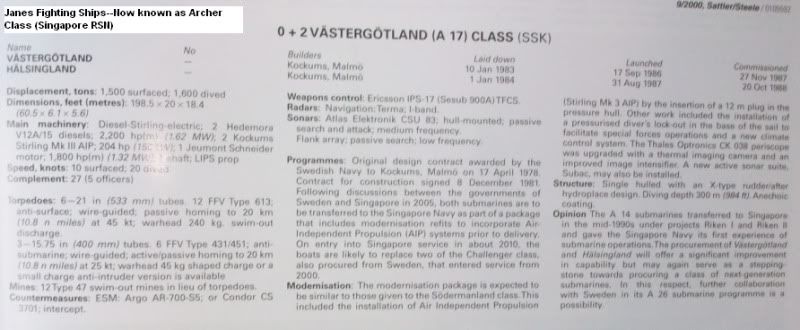
@@@@@@@@@
wwww
hhhh
tttt
Pl note life span of zao bao is only one week.Therefore i paste the news here.
zao bao cover more defense news than ST.Why?
与挑战者级比较 射手级潜艇更�猛
(2009-06-17)
与挑战者级潜艇比较,射手级潜艇有更强的潜航,声纳侦察能力和鱼雷ç�«åŠ›å�Šå‘½ä¸çŽ‡ä¹Ÿæ›´é«˜ã€‚它å�¯æ½œèˆªçš„æ—¶é—´æ›´é•¿ï¼Œå£°çº³ä¾¦å¯ŸèŒƒå›´æ›´è¿œï¼Œè€ŒæŠ—èˆ¹èˆ°æŠ—æ½œè‰‡é±¼é›·å°„ç¨‹ä¹Ÿæ›´è¿œï¼Œå¹¶å…·å¤‡ç›®æ ‡é”�定功能。
射手级潜艇翻新自上世纪80å¹´ä»£å»ºé€ çš„çº¦ç‰¹å…°çº§æ½œè‰‡ï¼Œæ¯”1960å¹´ä»£å»ºé€ çš„æŒ‘æˆ˜è€…çº§æœ‰æ›´å…ˆè¿›è£…å¤‡ã€‚
“射手å�·”舰长æ�¨ç§‹å�¥ä¸æ ¡ï¼ˆ36å²�)在å�¡å°”斯克é²�纳海军基地å�—访时说,新旧潜艇的两大ä¸�å�Œæ˜¯å°„手级安装“ä¸�ä¾�赖空气推进”(Air Independent Propulsion)系统外,也改良声纳和鱼雷å�‘å°„ç‰è£…备。
“ä¸�ä¾�赖空气推进”系统让射手级潜艇的最长航海时间也比挑战者级多一å€�,å�¯è‡ªç»™è‡ªè¶³é•¿å…星期。
æ�¨ç§‹å�¥è¯´ï¼ŒåŽŸæœ‰çš„西约特兰级潜艇å�ªé•¿48.5公尺,为装置“ä¸�ä¾�赖空气推进”ç³»ç»Ÿï¼Œåˆ¶é€ å•†ä¸ºå®ƒä»¬åŠ¨“接肢手术”ï¼ŒæŠŠè‰‡èº«åŠ é•¿12公尺。
“ä¸�ä¾�赖空气推进”系统的å�¦ä¸€å¥½å¤„是å‡�低潜航噪音,从而å‡�少被敌军å�‘现的å�¯èƒ½æ€§ã€‚
他说:“当潜艇å�—到å¨�èƒ�进入沉默状æ€�(silent routine)时,å�³ä½¿æœ‰æ°´æ‰‹ä¸�å°�心掉了一枚å°�å°�的五分钱硬å¸�,所å�‘出的声音也å�¯èƒ½ä¼šè¢«æ•Œå†›çš„声纳探测到,ä¸�仅打è�‰æƒŠè›‡ï¼Œä¹Ÿæš´éœ²è¡Œè¸ªï¼Œä¸¥é‡�çš„è¯�å�¯èƒ½è‡´å‘½ï¼�”
他说,由于很多器æ��ä¸�直接安装艇身上,而是远离艇身一段è·�ç¦»ï¼Œå› æ¤æ“�作器æ��æ—¶å�¯å‡�å°‘ä¸�å¿…è¦�噪音,使射手级的隔音能力比挑战者级强许多。虽然如æ¤ï¼Œæ‰€æœ‰äººå‘˜ä»�必须把声é‡�é™�è‡³æœ€ä½Žï¼Œå…³é—¨èµ°è·¯éƒ½å¾—æ ¼å¤–æ³¨æ„�。
射手级也有更先进的声纳和鱼雷装备。它的主动和被动声纳除�侦察到比挑战者级远一�的敌军水雷或船艇,现在也�进行追踪工作。
它的鱼雷也å�¯æ›´ç²¾å‡†é”€æ¯�æ›´è¿œçš„ç›®æ ‡ï¼Œå°„ç¨‹æ˜¯çŽ°æœ‰æŒ‘æˆ˜è€…çº§çš„ä¸€å€�å�Šã€‚设在潜艇下层的鱼雷舱,上方有6座533毫米鱼雷å�‘射管,下方是3座400毫米å�‘射管;比现挑战者级多出3个管(4+2)。鱼雷手å�ªéœ€è½»æŒ‰çº½ï¼Œå¼¹æŒ‡ä¹‹é—´å°±èƒ½æŠŠé±¼é›·è‡ªåŠ¨æŽ¨å…¥å�‘射管。
æ�¨ç§‹å�¥ä¸�æ„¿é€�露射手级的潜深能力,å�ªè¯´å’ŒæŒ‘æˆ˜è€…çº§ä¸€æ ·ï¼Œå¹¶è¯´ä¸€èˆ¬ç”±æŸ´æ²¹ç”µåŠ¨å¼•æ“Žå�‘动的潜艇,å�¯æ·±å…¥æ°´ä¸‹è¿žä¸‰ç™¾å…¬å°ºã€‚æ–°åŠ å�¡å‘¨å›´æµ·åŸŸæ°´æ·±çº¦80公尺,与瑞典毗邻的波罗得海(Baltic Sea)相似。
å°„æ‰‹çº§è¿”æ–°åŠ å�¡å‰�
è¦�进行çƒå¸¦æ°´æ¸©æµ‹è¯•
è·ŸæŒ‘æˆ˜è€…çº§ä¸€æ ·ï¼Œå°„æ‰‹çº§å›žè¿”æ–°åŠ å�¡å‰�得进行“çƒå¸¦æ°´æ¸©æµ‹è¯•”(tropicalisationï¼‰å·¥ä½œã€‚è¥¿çº¦ç‰¹å…°çº§æ ¹æ�®ç‘žå…¸æ°´åŸŸçš„æµ·åº•çŽ¯å¢ƒè®¾è®¡ï¼Œå’Œæ–°åŠ å�¡ 所处的çƒå¸¦åœ°åŒºæœ‰æ˜Žæ˜¾ä¸�å�Œã€‚çƒå¸¦æ°´åŸŸä¼šåŠ 速寄生物在金属表é�¢æ»‹ç”Ÿï¼Œå�Œæ—¶é‡‘属也容易被高咸度çƒå¸¦æµ·æ°´ä¾µèš€ã€‚å› æ¤ï¼Œåœ¨æ½œè‰‡ç§»äº¤æ–°åŠ å�¡æµ·å†›å‰�é¡»ç»�过“çƒå¸¦æ°´æ¸©æµ‹ 试”,确ä¿�它们能在çƒå¸¦çŽ¯å¢ƒæ“�作。
国防部说,潜艇外身的钢管和活门将æ�¢æˆ�é“œé•�å�ˆé‡‘ä»¥åŠ å¼ºè‰‡èº«è€�èš€æ€§ï¼›æ½œè‰‡ä¹Ÿä¼šåŠ è£…ä¿�护系统和三å�°æ°Ÿåˆ©æ˜‚压缩机(freon compressor),å‰�者å‡�低寄生物在金属表é�¢æ»‹ç”Ÿï¼Œå�Žè€…åŠ å¼ºæ½œè‰‡çš„å†·å�´åŠŸèƒ½ã€‚
射手级艇身为å�•å£³è®¾è®¡ï¼Œæœ‰ä¸¤å±‚甲æ�¿ã€‚引擎室ã€�机房ã€�辅机å�Šæœºå™¨å®¤ï¼ˆauxillary and machinery room)å� 上下两层,而指挥室和起居室å�ªåœ¨ä¸Šå±‚,鱼雷舱在下层。
射手å�·7å��军官和21å��水手已在瑞典è®ç»ƒä¸¤å¹´ï¼ŒåŒ…括潜艇æ�œæ•‘æ¼”ä¹ ã€‚å‰‘å®¢å�·äººå‘˜åŽ»å¹´å¼€å§‹åœ¨ç‘žå…¸å�—è®ã€‚
负责我国海军è®ç»ƒçš„瑞士海军第一纵队å�¸ä»¤é‚£æ ¼ä»�(Jonas Naggren)ä¸æ ¡è¯´ï¼Œæ–°åŠ å�¡äººå‘˜10å¹´å‰�已掌æ�¡æŒ‘战者级è¿�作,å¦ä¹ 射手级驾轻就熟,所需的培è®æ—¶é—´ä¹Ÿç¼©çŸã€‚
副总ç�†å…¼å›½é˜²éƒ¨é•¿å¼ 志贤在射手å�·ä¸‹æ°´ç¤¼ä¸Šæ„Ÿè°¢ç‘žå…¸åœ¨æ½œæ°´è‰‡æŠ€æœ¯å�‘展方é�¢ç»™äºˆæ–°åŠ å�¡çš„å��助。他说,射手å�·ä¸‹æ°´æ˜¾ç¤ºä¸¤å›½åœ¨å›½é˜²æ–¹é�¢çš„密切å�ˆä½œå’Œæ·±åŽšå�‹è°Šã€‚
他说,两国é�¢å¯¹ç›¸å�Œçš„的挑战å�Šå…³æ³¨çš„课题,两国人å�£ä¸�大,得ä¾�é� æ•™è‚²äººæ°‘å–„ç”¨ç§‘æŠ€åŠ å¼ºé˜²å�«èƒ½åŠ›ï¼Œå› æ¤è‡ª1970年已建立å�‹å¥½çš„防务关系。
1990年代åˆ�,海军使用瑞典的猎雷艇(mine-hunters),瑞典海军也å��åŠ©æ–°åŠ å�¡å»ºç«‹å��水雷能力。  数年å�Žï¼Œæ–°åŠ å�¡ç»„建潜艇部队,å�‘在这方é�¢æœ‰ç™¾å¤šå¹´ç»�验的瑞典拜师,并è´ä¹°“索尔门”(Sjoormen)级潜艇,翻修å�Žæ”¹ç§°æŒ‘战者级。
-
潜水艇知识问ç”
(2009-06-17)
*潜水艇有什么功能?
潜艇在æ��å�«æµ·è¿�ã€�支æ�´æµ·æˆ˜å’Œä¸ºç™»é™†æˆ˜æŠ¤èˆªæ–¹é�¢ä¸¾è¶³è½»é‡�。它利用水层掩护进行éš�蔽活动,利于对敌舰å�‘动çª�è¢ã€‚有较大的自给力ã€�ç»èˆªåŠ›å’Œä½œæˆ˜å�Šå¾„,让它å�¯è¿œ 离本土,长时间在大海洋或深入敌方海区独立作战。é…�备水下导弹ã€�鱼雷和水雷ç‰æ¦å™¨ä½¿å®ƒå…·å¤‡æ”»å‡»æµ·é™†ç›®æ ‡çš„å¨�åŠ›ã€‚æ–°åŠ å�¡æ½œè‰‡æ ¹æ�®ä½œæˆ˜ç�†è®ºéœ€è¦�,装备对付船舰 和潜艇两ç§�鱼雷。å�„å›½å› æ¤å�‘展潜战能力,以çª�ç ´æˆ–å»ºç«‹æµ·ä¸Šå°�é”�。潜艇ä¸�æ˜“è¢«ä¾¦å¯Ÿï¼Œå› æ¤ä¹Ÿè´Ÿèµ·è°�报任务,摸黑浮出观察敌动。
*有了护�舰和�潜直�机,为何还�有潜水艇?
å��击潜艇,须以其人之é�“还治其人之身,以潜打潜。一些潜艇å�¯æ½œæ·±ä¸‰å››ç™¾ç±³ï¼Œå�ªæœ‰æ½œè‰‡æ‰�能深入海底跟踪和摧æ¯�。护å�«èˆ°å’Œèˆ°è½½å��潜机作战å�Šå¾„有é™�,而且在水é�¢å’Œç©ºä¸ä¹Ÿå®¹æ˜“被侦察。
å�—ä¸å›½æµ·æµ·åºŠæµ…,深度ä¸�å�‡ï¼Œæµ·æµ�强而噪音æ�‚,温跃层(thermal layer,海水温度éš�深度急剧å�˜åŒ–的水层,它将海水分æˆ�上下水温截然ä¸�å�Œå±‚é�¢ï¼‰å�˜åŒ–大,会å�‘出æ�‚声,让潜水艇å�¯ä½œä¸ºæŽ©æŠ¤ï¼Œä¸�æ˜“ä¾¦å¯Ÿï¼Œæ½œè‰‡å› æ¤æˆ�为å�—ä¸å›½æµ·ä¸Šæœ€è‡´å‘½æµ·æˆ˜æ¦å™¨ã€‚
*海军已有4艘挑战级潜水艇,为何还�买射手级?
挑战级潜艇属A12型,艇身å°�,鱼雷数é‡�有é™�,对船舰10枚,打潜艇4枚。海军10多年å‰�è´ä¹°æŒ‘战级时,ä¸�ä¾�赖空气推进系统(Air-Independent Propulsion)ä¸�æ™®é��,三天两头得浮水å�¸æ°”。
射手级A17型,AIP使它å�¯æ½œè¡Œæœ€å°‘14天,也å‡�ä½Žæ½œè‰‡æ½œèˆªå™ªéŸ³ï¼ŒåŠ å¼ºéš�秘。它的壳表附有消声层(anechoic layer),å�¯å�¸æ”¶å£°æ³¢å’Œé›·è¾¾ä¿¡å�·è€Œä¸�å��å°„ï¼ŒåŠ å¼ºèº²é�¿ä¾¦å¯Ÿèƒ½åŠ›ã€‚本身的先进声纳系统则使侦察范围更远。舰载12枚抗船舰和6枚抗潜艇鱼雷,使射手级ç�«åŠ› 更强。鱼雷å�‘å°„ç³»ç»Ÿä¹Ÿé™„è®¾ç›®æ ‡é”�定装置,å�¯æ›´è¿œå¤„击ä¸ç›®æ ‡ã€‚它的533毫米弹头240公斤,å�¯ä»¥45节(85公里)速度击ä¸20公里外船舰,而æ¼æ½œçš„ 400æ¯«ç±³çˆ†ç ´å¼¹å¤´45公斤,å�¯ä»¥25节(45公里)速度击ä¸20公里外潜水艇。
*为什么买二手潜水艇?
这符å�ˆå®ƒåœ¨å†›è´¹ ä¸Šç²¾æ‰“ç»†ç®—åŽŸåˆ™ã€‚æ— è®ºæ˜¯æˆ˜è½¦ã€�æˆ˜æœºæˆ–å†›èˆ°ï¼Œæ–°åŠ å�¡è®¤ä¸ºäºŒæ‰‹è´§ä¸�会差到那里去,é‡�è¦�的是æ¦å™¨ç³»ç»ŸæŠ€æœ¯ã€‚买现æˆ�å�¯èŠ‚çœ�å»ºé€ æ—¶é—´å’Œè´¹ç”¨ï¼Œå�ªæœ‰å¹³å�°ï¼ˆèº¯å£³ï¼‰ç¿»æ–°æ— 法达到作战è¦�求æ‰�考虑新货。æ¦å™¨ç§‘技日新月异,今天买下的æ¦å™¨ï¼Œå�¯èƒ½å¾ˆå¿«è�½ä¼�,买二手较符å�ˆç»�济效益。
*为什么跟瑞典�作?
瑞典是潜艇技术先进和å�‘达,是最早å�‘展和è�½å®žAIPæ½œè‰‡çš„å›½å®¶ä¹‹ä¸€ã€‚å®ƒçš„æ½œè‰‡æ´»åŠ¨åŒºåœ¨æ³¢ç½—çš„æµ·ï¼Œæµ·åºŠè·Ÿæ–°åŠ å�¡æ°´åŸŸä¸€æ ·80å¤šç±³æ·±ï¼Œè€Œä¸”å®ƒè·Ÿæ–°åŠ å�¡ä¸€æ ·ï¼Œ 海港和海è¿�ç¹�å¿™ï¼Œå› æ¤ç”±å®ƒå�‘展的潜艇技术最适å�ˆæ–°åŠ å�¡çš„è¦�求。它在冷战时ç»�常侦察ç»�过波罗的海的è‹�è�”æ½œè‰‡ï¼Œå› æ¤æ½œè‰‡éš�秘和侦察技术强。瑞典为其ä¸ä¸¤è‰˜è¥¿çº¦ 特兰级潜艇装备AIP,改称瑟德尔门兰德(Sodermanland)级,å†�按照瑟德尔门兰德级设计å�¦é€ 3艘潜艇称哥特兰德(Gotland)级。美国海 军甚至租用哥特兰德级潜艇供å��潜练兵用。
*东�亚哪些国家也有潜水艇?
列强在冷战å�Žæ’¤å‡ºä¸œå�—亚,使区域出现海底军力真 空,东å�—亚国家纷纷在上世纪90年代建立潜艇实力。å�°å°¼æœ€æ—©æ‹¥æœ‰æ½œè‰‡ï¼Œåœ¨50年代å�–得数艘è‹�è�”å’Œæ³¢å…°åˆ¶é€ æ½œè‰‡ï¼Œä½†æ—©å·²æŠ¥åºŸï¼Œå®ƒåœ¨90年代买了两艘德国制 209åž‹æ½œæ°´è‰‡ï¼Œä½†æ— è®ºæ˜¯å¹³å�°æˆ–系统已è�½ä¼�ï¼Œæ— æ³•èƒœä»»å·¡é€»ä»»åŠ¡ã€‚å�°å°¼å·²å�‘韩国订è´4艘潜水艇。
越å�—有两艘æœ�鲜制“裕å�¤”(Yugo)级 微型潜艇,排水é‡�70å�¨çº§ï¼Œæ— 法远航。泰国一直表示è¦�买,å�´å�ªé—»æ¥¼æ¢¯å“�。马æ�¥è¥¿äºšä¹°äº†ä¸¤è‰˜æ³•å›½DCN和西ç�ç‰™åˆ¶é€ çš„å¤©è�Žçº§ï¼ˆScorpene,或鲉鱼级) 潜艇,虽被认为éš�声性很强,但没有AIP装置,而且å�ªè£…备6座鱼雷管,æ�ºå¸¦18枚抗舰鱼雷,没有抗潜水艇鱼雷。
-
I believe we r using Black Shark torps - range 50km, speed 50 knots
-
fff
-
I suggest u buy zaobao today.There is much more coverage .
-
Originally posted by spartan_6:
I believe we r using Black Shark torps - range 50km, speed 50 knots
u are right..
Singapore selects Black Shark torpedo - Jane's Defence Weekly
-
here are few items i found in past exhitbitions relating to the sea warfare--
can u guys share your treasury but unclassified info here?
Meredith AUV ---Defence Tech 2008 in SG science center by DSO.
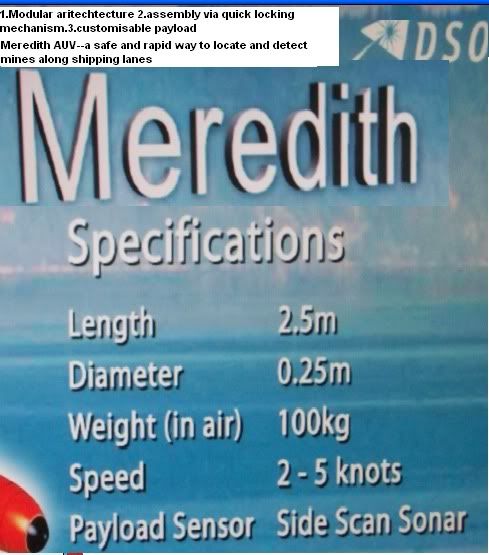
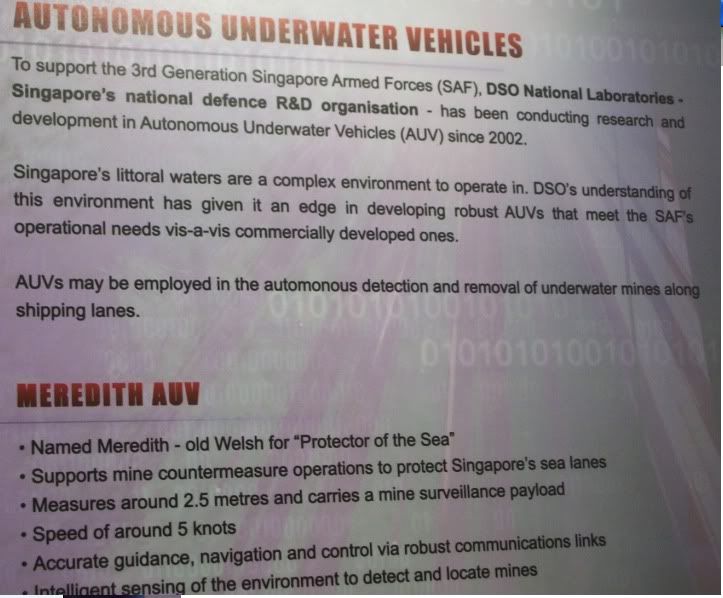
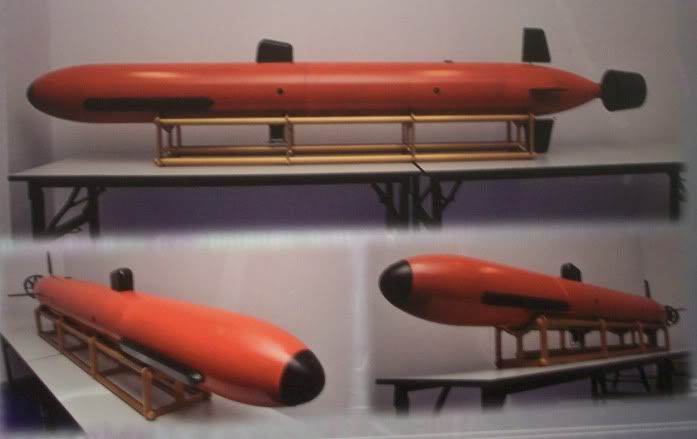
@@@@@@@
Aero space Asia 2006--Expendable mini destructor by ST Dynamics & L3.
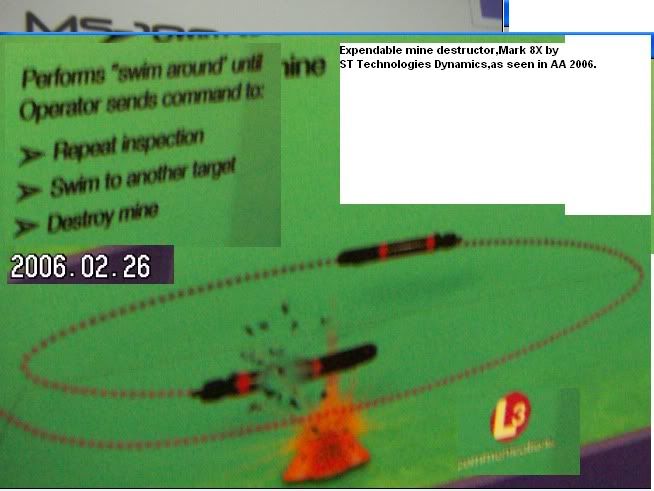
@@@@@@@@@
side look sonar.also in AA 2006.most likely displayed by ST.

-
Originally posted by spartan_6:
I believe we r using Black Shark torps - range 50km, speed 50 knots
it sounds like it will do the job and the same one as malaysia
http://www.subsim.com/radioroom//showthread.php?t=90065
the italian/french Development of Black Shark began in 1997 to meet the Italian Navy's requirement for a new-generation heavyweight torpedo for its new U212A-class submarines. Originally known as the A184 Advanced - indicating its provenance in the earlier A184 Mod 3 heavyweight torpedo - the weapon was renamed to reflect WASS' assertion that its capabilities were significantly superior to the legacy A184 line. DCN St Tropez, as partner to WASS, is taking responsibility for the development of the Black Shark's battery system and electric motor.
Black Shark incorporates a new Advanced Sonar Transmitting and Receiving Architecture (ASTRA) active/passive acoustic homing head; an updated guidance-and-control section; a fibre-optic guidance link and spool; a new electric motor; and a skewed contra-rotating propeller. ASTRA, originally developed under a separate national programme, is a multibeam steerable planar array with digital pulse compression in any transmission mode, multifrequency operations in both active (frequency modulation and continuous wave) and passive modes, and independent processing of each frequency (active and passive) on each lobe.
ASTRA operates at 15 kHz (passive medium frequency only) and 30 kHz (active and passive high frequency). The seeker can operate simultaneously in both frequencies in passive mode, allowing the torpedo to discriminate between signals from a real target and signals from an acoustic countermeasure decoy. A fibre-optic link has been introduced in place of a conventional wire-guidance link. This carries sensor data and command and guidance signals to and from the submarine, allowing the torpedo to operate as a forward-deployed sensor for the submarine. Use of optical fibre allows a higher data exchange rate between the submarine and its weapon, offering a nominal 100 per cent increase in guidance range.
Propulsion is provided by a brushless axial flux motor powered by a new AlAgO battery fitted with an electrolyte management system (a low-cost rechargeable lithium ion battery is being developed for exercise use).
The propulsor itself uses contra-rotating 13-blade and 10-blade carbon fibre propellers. Top speed exceeds 52 kt.
Black Shark has entered low-rate production prior to final completion of acceptance testing. A first operational launch was undertaken in November 2004 from O'Higgins, the first of two Scorpene submarines being acquired by the Chilean Navy. The trial, forming part of the submarine's acceptance programme, was carried out by DCN International in international waters along the French-Spanish coastline.
Chile also plans to outload Black Shark to its two Type 209/1300 submarines, Thompson and Simpson. Both boats are to receive a command and weapon-control system update from UDS International, which will offer commonality with the Scorpenes and enable them to operate Black Shark alongside the existing SUT weapon.
Italy will outload Black Shark on to its new U212A submarines, Salvatore Todaro and Sciré. It will also equip the existing submarines of the Sauro class, which are currently armed with the A184 Mod 3 heavyweight torpedo.
As well as being sold to Chile, Black Shark has also secured a berth aboard the two new Scorpene submarines being purchased by Malaysia from Armaris, and on the two Type 209/1500PN boats ordered by Portugal from Howaldtswerke-Deutsche Werft (part of ThyssenKrupp Marine Systems). -
more pics

http://www.mindef.gov.sg/imindef/publications/cyberpioneer/news/2009/June/17jun09_news.html
16 Jun 09 - Singapore Navy Launches Its First Archer-Class Submarine
16 Jun 09 - News Video: Singapore Navy Launches Its First Archer-Class Submarine -
http://www.zaobao.com.sg/yl/yl090618_001.shtml
This article from zao bao Deputy Editor says
the cost of 2 Archer class sub,including training and logistics ,costs US$ 128 million.
much cheaper than other new subs.
-
blank
-
Originally posted by lionnoisy:
æ–°åŠ å�¡ä¸ºä½•å¢žè´æ½œæ°´è‰‡ï¼Ÿ
(2009-06-18)
� 陈天明
æ–°åŠ å�¡ä¸ºä½•éœ€è¦�这么多潜水艇?其实,作为é� 航è¿�贸易为ç»�济命脉ã€�日常必需å“�主è¦�é� å…¥å�£çš„å°�å²›å›½ï¼Œæ–°åŠ å�¡æµ·å†›ä¸�能å�ªé¡¾æœ¬åœŸé˜²å�«ï¼Œæ›´è¦�防å�«æµ·è¿�线,确ä¿�è´§è¿�通畅,ä¸�å�—海上å°�é”�å¨�èƒ�。
å½“æ–°åŠ å�¡åœ¨å��多年å‰�宣布è´ä¹°æŒ‘战者级潜水艇,æˆ�为东å�—亚第一个实际è¿�作潜水艇的国家å�Žï¼Œå�°å°¼å’Œé©¬æ�¥è¥¿äºšä¹Ÿç›¸ç»§åŠ å…¥å�‘å±•æ½œæ°´è‰‡çš„è¡Œåˆ—ã€‚æ–°åŠ å�¡çš„举动被批评为掀起新的区域军备竞赛。
ä¸�过,å�°å°¼ç»�济å�—1997年亚洲金èž�风暴打击,军费开支å�—牵连,å�‘展潜水艇实力计划è�½ç©ºï¼Œå�Žé�—症到现在还未æ�¢å¤�。马æ�¥è¥¿äºšåˆ™åœ¨äºšæ´²ç»�济å�±æœºå�Žæ€¥èµ·ç›´è¿½ï¼Œè´ä¹°ä¸¤è‰˜å¤©è�Žçº§ï¼ˆScorpene,或鲉鱼级)潜水艇。
天è�Žçº§åœ¨éš�ç§˜æŠ€æœ¯ä¸Šæ¯”æŒ‘æˆ˜è€…çº§å¼ºï¼Œå†›äº‹è¯„è®ºå› æ¤è®¤ä¸ºåŒºåŸŸå†›åŠ›å·²å�–å¾—å�‡è¡¡ï¼Œæ–°åŠ å�¡æµ·å†›å†�也å� ä¸�到优势。
马æ�¥è¥¿äºšæµ·äº‹ç ”究院评论员莫克å†�尼在2006年撰文说:“很显然的,天è�Žçº§æ½œè‰‡å·²å¨�èƒ�挑战者级ã€�甚至å¨�æ¦çº§æŠ¤å�«èˆ°ï¼Œæ‰©å¤§é©¬æ�¥è¥¿äºšçš„å��æ½œæˆ˜èƒ½åŠ›ï¼ŒæŒ‘æˆ˜äº†æ–°åŠ å�¡çš„海军优势地ä½�。”
ç†Ÿæ‚‰æ–°åŠ å�¡å›½é˜²åŽŸåˆ™çš„ä¸“å®¶ä¹Ÿå› æ¤è®¤ä¸ºï¼Œæ–°åŠ å�¡ä¸�会å��视海æ�ƒåŠ¿åŠ›å�—å¨�èƒ�,è´ä¹°è¥¿çº¦ç‰¹å…°çº§ï¼ˆå°„手级å‰�èº«ï¼‰æ˜¯æŠµæ¶ˆé‚»å›½åŠ å¼ºæµ·å†›å®žåŠ›çš„å¿…ç„¶æˆ˜ç•¥å†³å®šã€‚èŽ«å…‹å†�尼说,射手级让东å�—亚海军实力å�‡è¡¡çš„称æ�†å†�倾å�‘æ–°åŠ å�¡ã€‚
“å‰�线防å�«”需è¦�潜艇支æ�´
å¾ˆå¤šæ–°åŠ å�¡äººä¹Ÿè®¸ä¼šè´¨ç–‘ï¼Œæ–°åŠ å�¡æœ¬å²›ä¸œè¥¿ä»…é•¿42公里,å�—北23公里,海岸线193公里长,领海界线离岸约5.5公里,领海é�¢ç§¯ä¸�过700平方公里,水深80米,为何需è¦�这么多潜水艇?
其实,作为é� 航è¿�贸易为ç»�济命脉ã€�日常必需å“�主è¦�é� å…¥å�£çš„å°�å²›å›½ï¼Œæ–°åŠ å�¡æµ·å†›ä¸�能å�ªé¡¾æœ¬åœŸé˜²å�«ï¼Œæ›´è¦�防å�«æµ·è¿�线,确ä¿�è´§è¿�通畅,ä¸�å�—海上å°�é”�å¨�èƒ�。
<!--ENDARTICLE-->
防å�«æµ·è¿�线æ„�味ç�€æ–°åŠ å�¡æµ·å†›çš„实力必须从近岸防å�«æ��å�‡åˆ°è¿‘海防å�«ã€‚亚ä¸�湾海盗问题,说明海事å¨�èƒ�å�¯ä»¥è¿œåœ¨å�ƒé‡Œå¤–ã€‚ä»¥æ–°åŠ å�¡æµ·å†›æ�¥è¯´ï¼Œå®ƒè¦�防守的包括å�—ä¸å›½æµ·å’Œé©¬å…甲海峡的航线,而ä¸�å�•æ˜¯700平方公里大领海。
除了海è¿�防å�«è€ƒé‡�,先天ä¸�足的陆地防御腹地(defence depthï¼‰è–„æµ…åŠ£åŠ¿ï¼Œä¹Ÿä½¿æ–°åŠ å�¡åœ¨å†›äº‹ä¸Šå¥‰è¡Œ“å‰�线防å�«”(forward defence)作战ç�†è®ºï¼Œå°±å¦‚马æ�¥è¥¿äºšä¹Ÿå£°ç§°å®ƒæœ‰é‡‡å�–“å‰�线防å�«”çš„ç�†ç”±ã€‚
当马æ�¥è¥¿äºšé¦–相纳å�‰è¿˜æ‹…任国防部长时,他在2004年在马æ�¥è¥¿äºšå†›äº‹å�‚è°‹å¦é™¢çš„讲è¯�ä¸é�“出所谓“å‰�线防å�«”就是境外防守。
“å‰�线防å�«”è¦�求陆战部队从海路出击敌阵,但登陆行动ä¸�能å�ªé� 空军和水é�¢æˆ˜èˆ°æŠ¤èˆªï¼Œæ›´éœ€è¦�潜艇支æ�´ï¼Œå¼€æ‹“立体战场。
以å�—ä¸å›½æµ·æ�¥è¯´ï¼Œæµ·åºŠæµ…,深度ä¸�å�‡ï¼Œæµ·æµ�强而噪音æ�‚,温跃层å�˜åŒ–大,让潜艇ä¸�æ˜“è¢«ä¾¦å¯Ÿï¼Œæ½œè‰‡å› æ¤æˆ�为本区域最致命的海战æ¦å™¨ã€‚å› æ¤å¦‚何在潜战ä¸æ›´èƒœä¸€ç¹ï¼Œå�„国ä¸�敢掉以轻心。
å†›äº‹è¯„è®ºç•Œè®¤ä¸ºï¼Œä»¥æ–°åŠ å�¡çš„防御腹地劣势,è¦�在军备方é�¢æ›´ä¸Šä¸€å±‚楼事ä¸�得已。éš�ç�€åŒºåŸŸå›½å®¶è¿‡åŽ»å‡ 年乘ç»�济好时大事采è´ï¼Œæ–°åŠ å�¡ä¸�å¾—ä¸�æ��高è¦æƒ•ï¼Œæœªé›¨ç»¸ç¼ªã€‚
è´ä¹°å‰�已掌æ�¡è¿�作模å¼�和技术
å¾ˆå¤šæ—¶å€™ï¼Œæ–°åŠ å�¡çœ‹ä¼¼è�½åœ¨åˆ«äººå�Žå¤´ï¼Œä¾‹å¦‚先进主战å�¦å…‹ã€�多管ç�«ç®ç‚®ã€�护å�«èˆ°å’Œæˆ˜æ–—机的采è´æ¯”马æ�¥è¥¿äºšæ…¢ï¼Œå®žé™…上它的高瞻远瞩作风,让它在采è´å‰�已掌æ�¡è¿�作模å¼�和技术。
以è´ä¹°å°„手级潜艇为例å�ï¼Œæ–°åŠ å�¡åœ¨èˆ¹èº«ç¿»æ–°è¿‡ç¨‹ä¸ï¼Œå·²åœ¨ä¸¤å¹´å‰�派全部28å��舰员到瑞典,以å�Œæ¬¾çš„西约特兰å�·ä¸ºè¯¾å®¤ï¼Œå¦ä¹ æ“�作射手级。当射手å�·å®Œæˆ�翻新,已有è®ç»ƒæœ‰ç´ 的水手å�¯ä»¥ä½¿å®ƒé©¬ä¸Šæœ�役。剑客å�·è¿˜æœªä¸‹æ°´ï¼Œå®ƒçš„舰员目å‰�已在瑞典è®ç»ƒã€‚
国防建设忌好高骛远å�Šä»¥“ä½ æœ‰ï¼Œæˆ‘ä¹Ÿè¦�有”的心æ€�è´ä¹°å†›å¤‡ã€‚一项军备的æœ�役期或建设期å�¯é•¿è¾¾äºŒä¸‰å��年。既然资æº�有é™�,军方须按部就ç�,有æ�¡ä¸�ç´Šåœ°æ ¹æ�®æ—¢å®šæ”¿ç–è´ä¹°éœ€è¦�的军备,以å…�浪费å®�贵的ç»�济资æº�å�Šä¸€ä»£äººçš„时间。
è´ä¹°äºŒæ‰‹æ¦å™¨åŠ 以翻新的å�šæ³•ï¼Œè®©æ–°åŠ å�¡èƒ½ä»¥æ›´å°‘的军费å�–得系统更精良ã€�更物有所值é…�套(å�–方确ä¿�è®ç»ƒå’Œå�Žå‹¤ä¾›åº”)的æ¦å™¨ï¼Œä¹Ÿæ›´å¿«çš„把æ¦å™¨å’Œç³»ç»ŸæŠ•å…¥æœ�役。
æ�®çŸ¥ï¼Œæ–°åŠ å�¡è´ä¹°çš„两艘射手级潜艇é…�套(包括å�Žå‹¤å’Œè®ç»ƒï¼‰å�ªæ˜¯1亿2800万美元(1亿8600ä¸‡æ–°åŠ å�¡å…ƒï¼‰ï¼Œå�°å°¼å�‘韩国è´ä¹°çš„å››è‰˜æ–°é€ æ½œæ°´è‰‡ï¼Œæ¯�艘已是2亿7000万美元(3亿9000ä¸‡æ–°åŠ å�¡å…ƒï¼‰ã€‚
马æ�¥è¥¿äºšé¦–相纳å�‰è¯´å¾—好,一个æˆ�功的国防政ç–包括有å�“阻ã€�å‰�线防å�«å’Œå…¨é�¢é˜²å�«èƒ½åŠ›ã€‚
实现�明度并建立国防互信
æ–°åŠ å�¡å›½é˜²ä¹Ÿå»ºç«‹åœ¨å�“é˜»å’Œå¤–äº¤ä¸¤å¤§æ”¯æŸ±ä¸Šã€‚æ–°åŠ å�¡å¿…须有一支强大军队å�‘挥å�“阻作用,它必须拥有能一战å�³èƒœçš„å†›å¤‡å’Œç´ è´¨ã€‚å°±å¦‚çº³å�‰æ‰€è¯´ï¼š“ä½ å¿…é¡»è®©æ½œåœ¨æ•Œ äººç›¸ä¿¡ä½ æœ‰èƒ½åŠ›æ”»å‡»å’Œå��击,让它知é�“如果轻举妄动势必招惹致命报å¤�。å�“阻手段的目的就是è¦�让敌人得出结论:动æ¦ä»£ä»·æƒ¨é‡�,得ä¸�å�¿å¤±”。
æ–°åŠ å�¡æ ¹æ�®å›½é˜²éœ€è¦�与时并进的更新军备,ä¸�应当被认为ä¸�义之举。
副总ç�†å…¼å›½é˜²éƒ¨é•¿å¼ 志贤在射手å�·ä¸‹æ°´ç¤¼ä¸Šè¯´ï¼š“射手级潜水艇连å�Œå…艘éš�形护å�«èˆ°ï¼Œä»¥å�Šå�³å°†äº¤è´§çš„海军直å�‡æœºï¼Œå°†è®©æµ·å†›èƒ½æ‰§è¡Œæ›´å¤�æ�‚和精密的任务,å��助维æŒ�区域安全和稳定,并ä¿�障本区域海è¿�的安全。”
马æ�¥è¥¿äºšä¸‹è®®é™¢å‰¯è®®é•¿æ—ºæœ±ä¹ƒè¿ªæœ€è¿‘为马å�°ä¸¤å›½å®‰å·´å�»æµ·åŸŸä¸»æ�ƒé—®é¢˜æŽ¥è§�å�°å°¼äººæ°‘å��商议会代表团时,针对有关马æ�¥è¥¿äºšå¢žæ·»å†›å¤‡å¼•èµ·å�°å°¼ä¸�安的å��æ˜ è€Œå›žç”说:“马æ�¥è¥¿äºšå¢žæ·»å†›å¤‡å¹¶é�žä¸ºäº†å�‘邻国宣战,而是在有必è¦�æ—¶å��助邻国一臂之力。”
一个国家尽管è´ä¹°å†›å¤‡çš„ç�†ç”±å……足,难å…�会引起其他相关国家ä¸�æ»¡ï¼Œå°¤å…¶æ˜¯è¿™äº›å›½å®¶ä¸ºäº†è½¬ç§»å†…éƒ¨é—®é¢˜è€Œæ— ç�†å�–闹,把动机简å�•è€Œå�ˆæƒ…å�ˆç�†çš„军备问题æ�žå¾—沸沸扬扬。
ä¹Ÿè®¸å¼ å¿—è´¤ä¸Šæœˆåœ¨“é¦™æ ¼é‡Œæ‹‰å¯¹è¯�”常年大会上所æ��出的å�„国在维æŒ�区域安全与和平ä¿�æŒ�军事é€�明的谈è¯�值得é‡�视。
他说,世界å�„国都在争å�–能æº�与天然资æº�,国际贸易航é�“å�ˆå�—æµ·ç›—å¨�èƒ�ï¼ŒåŠ ä¸Šäººå�£å¢žé•¿ï¼Œå·²ä½¿ä¸€äº›å›½å®¶ä¸ºæ›´å¥½åœ°æ��å�«èµ„æº�å�Šåº”付海盗ç‰å®‰å…¨å¨�èƒ�,于是添è´æ¦å™¨ä»¥æ��å�‡å†›äº‹èƒ½åŠ›ã€‚如果周边国家ä¸�ç�†è§£å®ƒä»¬æ¤ä¸¾çš„åŽŸå› ï¼Œå¾ˆå®¹æ˜“è§£è¯»ä¸ºæ‰©å……å†›åŠ›ï¼Œå¨�èƒ�ä»–å›½å®‰å…¨ï¼Œå› æ¤å�„国必须ä¿�æŒ�军事é€�明度。
ä½†å¼ å¿—è´¤å¼ºè°ƒï¼Œå†›äº‹é€�明度本身并é�žç»ˆæž�ç›®æ ‡ï¼Œå®ƒåº”å®žçŽ°çš„æ›´å¤§ç›®æ ‡æ˜¯é�¿å…�æ„�外å�Šäº’相误解而擦枪走ç�«ã€‚å› æ¤ï¼Œåœ¨å½“å‰�çš„äºšå¤ªæ ¼å±€ä¸ï¼Œå®žçŽ°é€�明度并é€�过对è¯�与å�ˆä½œæœºåˆ¶ï¼Œå»ºç«‹å›½é˜²äº’信,æ‰�是维æŒ�区域安全与和平的上ç–。
å�ªè¦�区域安全架构å�‘挥作用,è´ä¹°æ–°å†›å¤‡æ·˜æ±°è�½ä¼�军备应该是å�¯ä»¥æŽ¥å�—的国防举措。
作者为��早报副采访主任
pl click for zao bao news
-
E 2nd boat is named RSS Swordsman
-
one of the SG sub was formerly
HMS Vastergotland
http://outdoors.webshots.com/photo/1181513947046324430rHzisL
-
http://en.wikipedia.org/wiki/V%C3%A4sterg%C3%B6tland_class_submarine
Twenty First Century Submarines: Undersea Vessels of Today's Navies - Google 图书结果
-
Thanks for the post...
-
Video on SG Submarine Training in Sweden
source--http://militarynuts.com/index.php?showtopic=200&st=630
http://www.youtube.com/watch?v=zb3R0ouZQYA
-
AdelaideNow: Collins Class a Triumph
DEREK WOOLNER
May 12, 2008 12:15am
PEOPLE in the street and some sections of the media dismiss the navy's Adelaide-built Collins Class submarines as monumental duds.
In stark contrast, most insiders we interviewed, as the authors of the history of the project, consider them a naval engineering triumph and a monument of Australian nation-building.
From its inception in 1978 the project was seldom far from controversy and it was mercilessly attacked by the media and the Howard government for a myriad of technical failings – real, exaggerated and imagined.
It is widely believed to have been a financial disaster, yet it is one of the few military purchases where the original budget was still relevant at the end of the project.
Further, Australian industry responded successfully to the challenge of building submarines in this country, an achievement widely believed to be beyond Australian capabilities and one in which many other countries have failed disastrously.
During the 1970s the Australian Navy operated British-built Oberon diesel-electric submarines on some of the most secret intelligence-gathering missions of the ColdWar.
Nuclear submarines lacked the stealth for these covert operations, and the U.S. Navy encouraged Australian military planners and politicians to maintain the long-range intelligence-gathering capability in the Oberons' successor vessels.
At the same time the Australian submariners developed convincing arguments that submarines were the most effective vessels for use in long-range offensive operations in enemy waters.
Thus was born the desire to build the most modern long-range conventional submarine in the world.
Modernity would be attained through a then-revolutionary idea: Instead of taking whatever options for a combat system came with the design, the navy would specify the combat system which best met its needs and this would be developed separately from the submarine.
Further, following intense debate, it was decided to build the submarines in Adelaide as a focus for industrial regeneration and to provide better long-term maintenance and support than was usually received from overseas shipyards.
These factors determined the nature of the Collins project. To U.S. submariner Admiral Phil Davis, the project was a huge undertaking, a "monumental feat".
"There is really nothing in the history of submarine construction that has been done like that," he said of the transformation of a small Swedish submarine into a "radical new design", built 18,000km from the designer's office "in a new yard with a new workforce".
Amazingly, the project's objectives were largely delivered. Today, the Australian Navy operates sophisticated long-range submarines.
Peter Sinclair, the first skipper of HMAS Collins, who has wide experience with other conventional submarines, believes the Collins is more capable than any conventional submarine at sea, with a turning circle second to none and "super quiet at slow speed, quieter than anything else in the world".
Few thought that Australia's recession-ravaged industries of the early 1980s could build a submarine. Yet, with the introduction of modern techniques that accompanied the project, over 70 per cent of its value was produced in Australia by hundreds of subcontractors who embraced the exacting defence quality standards. The welding standards remain some of the best achieved in the world.
THE project suffered its share of problems but the only surprise, given the ambition of the project, was that they were not better anticipated.
With problems overcome through some remarkable defence science and assistance from the U.S., the submarines were delivered close to budget and an average of 26 months behind schedule.
This is one of the shortest delays with any military purchase and remarkable for the largest systems integration project in Australian history.
The persisting failure has been the combat system, a testament to both the inadequacies of some of the world's major arms corporations and the unchecked ambition of Australian submariners.
Even this disaster was salvaged by the expertise and ingenuity of Australia's project engineers and defence scientists, cobbling together a system to provide an acceptable performance.
Derek Woolner is an expert on defence procurement projects, and is Visiting Fellow at the Strategic and Defence Studies Centre at the Australian National University. He is co-author, with Peter Yule, of The Collins Class Submarine Story – Steel, Spies and Spin.
The Australian navy has six Collins Class submarines, designed by the Swedish company Kockums, and built by the Australian Submarine Corporation at Adelaide between 1989 and 2003. The construction of the Collins class submarines was Australia's largest and most controversial military purchase. The submarine project was subjected to an unprecedented level of media scrutiny and criticism, became highly politicised and on several occasions faced the prospect of being abandoned.
The general public perception of the submarine project is that it was a hugely expensive failure and that the submarines are noisy 'dud subs'. While I am far from being an apologist for the navy, it is amazing how wrong this perception is. The submarines were indeed expensive - all modern weapons are expensive - but the submarine project was one of Australia's few modern military purchases in which the initial budget was still relevant at the end of the project. The submarines were a financial success.
The Collins submarines had technical problems - all new and complex machinery has teething problems - but the general belief that they are 'noisy as a rock concert' is wrong. The reality is that they are probably the second-quietest submarines in the world, with the only quieter ones being the Swedish Gotland class, Kockums' next design after the Collins class. The minor noise problems of the early submarines, as with the other mechanical issues, have long since been solved.
However, the submarines suffered from one major defect which the media and the public never really picked up on. The combat system - that is the computer systems in the submarine used to find enemies and fire torpedoes or missiles at them - has been by far the largest problem for the Collins class submarines. The earlier Oberon class submarines had a largely Australian-built combat system which was one of the best in the world. When our submariners began planning the combat system for the new submarines, they naturally wanted an even better one. However, what they asked for proved to be too hard to build and the combat system never worked properly - in fact it was never finished - and it was abandoned in 2000.
The navy then ran a competition to select the best available combat system already in operation in foreign submarines - a competition won easily by a European electronics company. However, the result was overturned by the coalition government, which insisted that our submarines had to have an American combat system. As the Americans did not have a combat system suitable for non-nuclear submarines, the consequence was that it was not until 2007 that our submarines began to be fitted with a combat system of the standard hoped for when the submarines were designed back in the 1980s.
The media and the public (and even to a surprising extent, the navy) never understood the sheer scale, complexity and risk of the submarine project. Building submarines is hard and getting harder - far harder than building aeroplanes, the closest analogy is perhaps with space ships. To build a hull to withstand extreme water pressures has always been demanding but the increasing complexities of electronics and computer systems make modern submarines among the greatest of engineering challenges. Even countries with long histories of submarine construction often have problems, while countries attempting to build submarines for the first time regularly experience disasters. Dilapidated or abandoned shipyards from Buenos Aires to Bombay, littered with the relics of failed submarine projects testify to the magnitude of the challenges.
The submarine project was taken up with great enthusiasm by the Hawke government in the 1980s as a major nation building endevour to revitalise Australian manufacturing. Consequently the submarines were built in Australia rather than overseas and over 70% of the money spent on the submarines was spent in Australia - a far higher proportion than with most military purchases. The end result of the project is a squadron of submarines that are among the best conventional submarines in any navy in the world and rank with the F111s as Australia's most potent weapons. The Collins Class submarines were an extraordinary engineering achievement and it is testimony to the power of politics and the popular press (lionnoisy) that they are regarded as a disaster.
Australia leads the way in Submarine development, not STK!
The Future of Submarines Is Down Under
 The Collins class submarine replacement is getting a lot of attention. In case you are curious why the topic has suddenly came up in the media, it has little to do with any new movement and everything to do with politicians talking about it. These are the only details that matter on the subject to date.
The Collins class submarine replacement is getting a lot of attention. In case you are curious why the topic has suddenly came up in the media, it has little to do with any new movement and everything to do with politicians talking about it. These are the only details that matter on the subject to date.New Defence Minister Joel Fitzgibbon has ordered planning to begin on the next generation of submarines to replace the Royal Australian Navy's Collins-class fleet with the aim of gaining "first pass" approval for the design phase from cabinet's National Security Committee in 2011.
The 17-year project will be the largest, longest and most expensive defence acquisition since Federation, potentially costing up to $25 billion.
Everything else is speculation, mostly regarding what the new platform will be, hell we've done a bit of our own. In reality though, if you are looking towards an existing design as a contender for the Collins replacement, you are probably looking in the wrong place.
The Collins class had a tough start, was given a bad reputation, and to this day is one of the least understood weapons of war taxpayers in Australia probably do recognize by name. Perception drives the reality of the media, and in general the media misses the mark today when it talks about the Collins class submarines.
The truth is, the Collins class submarine is one of the best submarines in the world, anywhere. Only Japan and the United States are realistically contenders in a match game debate, it really is that good. Any American submariner who has served on a Seawolf or Virginia class submarine would feel comfortable in a Collins, the same tech exists. In fact, the same strike packages exist, the same mission profiles exist, and in many ways they handle the same roles for their respective services. The only real difference is the propulsion system and the size.
The Collins class may not be nuclear, but it is a fleet submarine. We have recently learned thanks to released documents that if they were allowed, Australian submariners could tell more than a few stories of cold war operations deep into Russian waters in the Pacific, and it is a good bet if they did it with older submarine platforms, they will conduct the same mission profiles with the Collin class, and the Collins class replacement.
There is a lot of speculation regarding what the requirements of the Collins class replacement will be. From my discussions with people who do know, this is all we actually know..., it will not be like anything on the market today outside the US, and when 2011 comes, we will only hear the generic details. We can only count on three specific requirements leading the design focus: Fuel cell technology, high energy requirements, and it will operate as an underwater mothership for both manned and unmanned deployable systems. There is currently nothing in the market that meets those requirements outside of the US, and sense it is unlikely Australia will go nuclear with its submarines, it means there is nothing in the market designed today likely to be the Collins submarine replacement.
Australia will introduce something new, likely to only be influenced by Japanese and American concepts and technologies. Of all the underwater programs under development today, if you are looking for the next 'game changer' in underwater warfare, the Collins class submarine replacement program is the program to keep your eye on. -
Originally posted by Jack412:
it sounds like it will do the job and the same one as malaysia
http://www.subsim.com/radioroom//showthread.php?t=90065
the italian/french Development of Black Shark began in 1997 to meet the Italian Navy's requirement for a new-generation heavyweight torpedo for its new U212A-class submarines. Originally known as the A184 Advanced - indicating its provenance in the earlier A184 Mod 3 heavyweight torpedo - the weapon was renamed to reflect WASS' assertion that its capabilities were significantly superior to the legacy A184 line. DCN St Tropez, as partner to WASS, is taking responsibility for the development of the Black Shark's battery system and electric motor.
Black Shark incorporates a new Advanced Sonar Transmitting and Receiving Architecture (ASTRA) active/passive acoustic homing head; an updated guidance-and-control section; a fibre-optic guidance link and spool; a new electric motor; and a skewed contra-rotating propeller. ASTRA, originally developed under a separate national programme, is a multibeam steerable planar array with digital pulse compression in any transmission mode, multifrequency operations in both active (frequency modulation and continuous wave) and passive modes, and independent processing of each frequency (active and passive) on each lobe.
ASTRA operates at 15 kHz (passive medium frequency only) and 30 kHz (active and passive high frequency). The seeker can operate simultaneously in both frequencies in passive mode, allowing the torpedo to discriminate between signals from a real target and signals from an acoustic countermeasure decoy. A fibre-optic link has been introduced in place of a conventional wire-guidance link. This carries sensor data and command and guidance signals to and from the submarine, allowing the torpedo to operate as a forward-deployed sensor for the submarine. Use of optical fibre allows a higher data exchange rate between the submarine and its weapon, offering a nominal 100 per cent increase in guidance range.
Propulsion is provided by a brushless axial flux motor powered by a new AlAgO battery fitted with an electrolyte management system (a low-cost rechargeable lithium ion battery is being developed for exercise use).
The propulsor itself uses contra-rotating 13-blade and 10-blade carbon fibre propellers. Top speed exceeds 52 kt.
Black Shark has entered low-rate production prior to final completion of acceptance testing. A first operational launch was undertaken in November 2004 from O'Higgins, the first of two Scorpene submarines being acquired by the Chilean Navy. The trial, forming part of the submarine's acceptance programme, was carried out by DCN International in international waters along the French-Spanish coastline.
Chile also plans to outload Black Shark to its two Type 209/1300 submarines, Thompson and Simpson. Both boats are to receive a command and weapon-control system update from UDS International, which will offer commonality with the Scorpenes and enable them to operate Black Shark alongside the existing SUT weapon.
Italy will outload Black Shark on to its new U212A submarines, Salvatore Todaro and Sciré. It will also equip the existing submarines of the Sauro class, which are currently armed with the A184 Mod 3 heavyweight torpedo.
As well as being sold to Chile, Black Shark has also secured a berth aboard the two new Scorpene submarines being purchased by Malaysia from Armaris, and on the two Type 209/1500PN boats ordered by Portugal from Howaldtswerke-Deutsche Werft (part of ThyssenKrupp Marine Systems).malaysia only express interest in blackshark... no orders were placed, none was ever delivered according to SISPRI.
and according to wat is known thus far... their subs are neither AIP capable nor planned to have AIP in the future.
lastly, the only weapons found on their subs are sub launch anti-ship exocet missiles.
-
Originally posted by tripwire:
malaysia only express interest in blackshark... no orders were placed, none was ever delivered according to SISPRI.
and according to wat is known thus far... their subs are neither AIP capable nor planned to have AIP in the future.
lastly, the only weapons found on their subs are sub launch anti-ship exocet missiles.
We will know if the Malaysian ordered Scorpene is ordered with AIP capability by observing its length. -
given singapore's massive anti-submarine arsenal at our disposal; 18 ASW capable ships from PVs, MCVs to stealth frigate, plus 6 dedicated ASW S-60B seahawk helicopter, 4 Fokker MPA with Surface search radar and 6 subs including 2 with AIP.
if i am the malaysian submarine commander... i would stay far far from singapore water...
-
ChannelnewsAsia reported 21 July 2009 - that a ’Singapore Navy Patrol Vessel - RSS Independence – hit underwater object near Pedra Branca, and sustained damage to hull’.
The waters around Pedra Branca has been patrolled intensively for decades, and are supposed to have been well charted.
What possibly could that Singapore Navy Patrol Vessel hit ?
With the constant movement of the continental plates, perhaps a sudden rise in the sea bed had created a new outcrop of rocks that was not known ?
Or at worst, was there an unknown "undersea object" that moved into the disputed area that was "supposed to have been resolved" in 2008 but not quite accepted by some parties ?
Does the Patrol Vessel have any sonar onboard and if it is constantly manned ?
-
Originally posted by tripwire:
given singapore's massive anti-submarine arsenal at our disposal; 18 ASW capable ships from PVs, MCVs to stealth frigate, plus ... subs including 2 with AIP. if i am the malaysian submarine commander i would stay far far from singapore water
hi my fren.can u restraint fr mention other countries name.
MOD will close this thread soon.Thanks.
Pl open a thread if u wan talk in your own way.
i dunt wan this thread closed,unless u wan to .
2.can i share my summary of RSN launchers.Pl correct me if i am wrong.

Pl note there are currently 6 Oz Adelaide class
Guided Missile Frigate,not 8 listed above.
http://www.sgforums.com/forums/1164/topics/368516
3.I am always wan to ask if SG is over power or Oz is under power?
A ping pong v a soccer field!!
-
Originally posted by SingaporeTyrannosaur:
AdelaideNow: Collins Class a Triumph
DEREK WOOLNER
May 12, 2008 12:15am
PEOPLE in the street and some sections of the media dismiss the navy's Adelaide-built Collins Class submarines as monumental duds.
In stark contrast, most insiders we interviewed, as the authors of the history of the project, consider them a naval engineering triumph and a monument of Australian nation-building.
From its inception in 1978 the project was seldom far from controversy and it was mercilessly attacked by the media and the Howard government for a myriad of technical failings – real, exaggerated and imagined.
It is widely believed to have been a financial disaster, yet it is one of the few military purchases where the original budget was still relevant at the end of the project.
Further, Australian industry responded successfully to the challenge of building submarines in this country, an achievement widely believed to be beyond Australian capabilities and one in which many other countries have failed disastrously.
During the 1970s the Australian Navy operated British-built Oberon diesel-electric submarines on some of the most secret intelligence-gathering missions of the ColdWar.
Nuclear submarines lacked the stealth for these covert operations, and the U.S. Navy encouraged Australian military planners and politicians to maintain the long-range intelligence-gathering capability in the Oberons' successor vessels.
At the same time the Australian submariners developed convincing arguments that submarines were the most effective vessels for use in long-range offensive operations in enemy waters.
Thus was born the desire to build the most modern long-range conventional submarine in the world.
Modernity would be attained through a then-revolutionary idea: Instead of taking whatever options for a combat system came with the design, the navy would specify the combat system which best met its needs and this would be developed separately from the submarine.
Further, following intense debate, it was decided to build the submarines in Adelaide as a focus for industrial regeneration and to provide better long-term maintenance and support than was usually received from overseas shipyards.
These factors determined the nature of the Collins project. To U.S. submariner Admiral Phil Davis, the project was a huge undertaking, a "monumental feat".
"There is really nothing in the history of submarine construction that has been done like that," he said of the transformation of a small Swedish submarine into a "radical new design", built 18,000km from the designer's office "in a new yard with a new workforce".
Amazingly, the project's objectives were largely delivered. Today, the Australian Navy operates sophisticated long-range submarines.
Peter Sinclair, the first skipper of HMAS Collins, who has wide experience with other conventional submarines, believes the Collins is more capable than any conventional submarine at sea, with a turning circle second to none and "super quiet at slow speed, quieter than anything else in the world".
Few thought that Australia's recession-ravaged industries of the early 1980s could build a submarine. Yet, with the introduction of modern techniques that accompanied the project, over 70 per cent of its value was produced in Australia by hundreds of subcontractors who embraced the exacting defence quality standards. The welding standards remain some of the best achieved in the world.
THE project suffered its share of problems but the only surprise, given the ambition of the project, was that they were not better anticipated.
With problems overcome through some remarkable defence science and assistance from the U.S., the submarines were delivered close to budget and an average of 26 months behind schedule.
This is one of the shortest delays with any military purchase and remarkable for the largest systems integration project in Australian history.
The persisting failure has been the combat system, a testament to both the inadequacies of some of the world's major arms corporations and the unchecked ambition of Australian submariners.
Even this disaster was salvaged by the expertise and ingenuity of Australia's project engineers and defence scientists, cobbling together a system to provide an acceptable performance.
Derek Woolner is an expert on defence procurement projects, and is Visiting Fellow at the Strategic and Defence Studies Centre at the Australian National University. He is co-author, with Peter Yule, of The Collins Class Submarine Story – Steel, Spies and Spin.
The Australian navy has six Collins Class submarines, designed by the Swedish company Kockums, and built by the Australian Submarine Corporation at Adelaide between 1989 and 2003. The construction of the Collins class submarines was Australia's largest and most controversial military purchase. The submarine project was subjected to an unprecedented level of media scrutiny and criticism, became highly politicised and on several occasions faced the prospect of being abandoned.
The general public perception of the submarine project is that it was a hugely expensive failure and that the submarines are noisy 'dud subs'. While I am far from being an apologist for the navy, it is amazing how wrong this perception is. The submarines were indeed expensive - all modern weapons are expensive - but the submarine project was one of Australia's few modern military purchases in which the initial budget was still relevant at the end of the project. The submarines were a financial success.
The Collins submarines had technical problems - all new and complex machinery has teething problems - but the general belief that they are 'noisy as a rock concert' is wrong. The reality is that they are probably the second-quietest submarines in the world, with the only quieter ones being the Swedish Gotland class, Kockums' next design after the Collins class. The minor noise problems of the early submarines, as with the other mechanical issues, have long since been solved.
However, the submarines suffered from one major defect which the media and the public never really picked up on. The combat system - that is the computer systems in the submarine used to find enemies and fire torpedoes or missiles at them - has been by far the largest problem for the Collins class submarines. The earlier Oberon class submarines had a largely Australian-built combat system which was one of the best in the world. When our submariners began planning the combat system for the new submarines, they naturally wanted an even better one. However, what they asked for proved to be too hard to build and the combat system never worked properly - in fact it was never finished - and it was abandoned in 2000.
The navy then ran a competition to select the best available combat system already in operation in foreign submarines - a competition won easily by a European electronics company. However, the result was overturned by the coalition government, which insisted that our submarines had to have an American combat system. As the Americans did not have a combat system suitable for non-nuclear submarines, the consequence was that it was not until 2007 that our submarines began to be fitted with a combat system of the standard hoped for when the submarines were designed back in the 1980s.
The media and the public (and even to a surprising extent, the navy) never understood the sheer scale, complexity and risk of the submarine project. Building submarines is hard and getting harder - far harder than building aeroplanes, the closest analogy is perhaps with space ships. To build a hull to withstand extreme water pressures has always been demanding but the increasing complexities of electronics and computer systems make modern submarines among the greatest of engineering challenges. Even countries with long histories of submarine construction often have problems, while countries attempting to build submarines for the first time regularly experience disasters. Dilapidated or abandoned shipyards from Buenos Aires to Bombay, littered with the relics of failed submarine projects testify to the magnitude of the challenges.
The submarine project was taken up with great enthusiasm by the Hawke government in the 1980s as a major nation building endevour to revitalise Australian manufacturing. Consequently the submarines were built in Australia rather than overseas and over 70% of the money spent on the submarines was spent in Australia - a far higher proportion than with most military purchases. The end result of the project is a squadron of submarines that are among the best conventional submarines in any navy in the world and rank with the F111s as Australia's most potent weapons. The Collins Class submarines were an extraordinary engineering achievement and it is testimony to the power of politics and the popular press (lionnoisy) that they are regarded as a disaster.
Australia leads the way in Submarine development, not STK!
Everything else is speculation, mostly regarding what the new platform will be, hell we've done a bit of our own. In reality though, if you are looking towards an existing design as a contender for the Collins replacement, you are probably looking in the wrong place.
The Collins class had a tough start, was given a bad reputation, and to this day is one of the least understood weapons of war taxpayers in Australia probably do recognize by name. Perception drives the reality of the media, and in general the media misses the mark today when it talks about the Collins class submarines.
The truth is, the Collins class submarine is one of the best submarines in the world, anywhere. Only Japan and the United States are realistically contenders in a match game debate, it really is that good. Any American submariner who has served on a Seawolf or Virginia class submarine would feel comfortable in a Collins, the same tech exists. In fact, the same strike packages exist, the same mission profiles exist, and in many ways they handle the same roles for their respective services. The only real difference is the propulsion system and the size.
The Collins class may not be nuclear, but it is a fleet submarine. We have recently learned thanks to released documents that if they were allowed, Australian submariners could tell more than a few stories of cold war operations deep into Russian waters in the Pacific, and it is a good bet if they did it with older submarine platforms, they will conduct the same mission profiles with the Collin class, and the Collins class replacement.
There is a lot of speculation regarding what the requirements of the Collins class replacement will be. From my discussions with people who do know, this is all we actually know..., it will not be like anything on the market today outside the US, and when 2011 comes, we will only hear the generic details. We can only count on three specific requirements leading the design focus: Fuel cell technology, high energy requirements, and it will operate as an underwater mothership for both manned and unmanned deployable systems. There is currently nothing in the market that meets those requirements outside of the US, and sense it is unlikely Australia will go nuclear with its submarines, it means there is nothing in the market designed today likely to be the Collins submarine replacement.
Australia will introduce something new, likely to only be influenced by Japanese and American concepts and technologies. Of all the underwater programs under development today, if you are looking for the next 'game changer' in underwater warfare, the Collins class submarine replacement program is the program to keep your eye on.u can copy and paste any things.
Like US Navy sweetie comments on Collins capacity etc
Beware of conflict of interest.Yankee supplied the new combat sys to Collins.
Joel Fitzgibbon admits 'challenge' manning Collins-class ...
-
But can u tell me why---
1.No FOC or IOC have been declared for any Collins sub?
2.currently,only
so short of that it can barely put three of its six Collins-class boats to sea.
The hot econnomy and high pay in mining industries cannt explain the sever
shortage of crews.Do u know one sub nearly sink when a host bursted?
Oz ppple know their subs very well,too well.
3.How can u explain almost two third of 6 subs stayed in docks in
a year.Unbelieveable!! do u think upgrade can exaplin every things.
I think The words "get well " programmes by Janes Fighting Ships
is the best descriptions.The subs were sick!!
Time that 6 subs in docks!!57%,60% and 39 %!!
OMG!U have to test the subs and train the crews after docking.Right?
So,how many time that the subs can put to operations?
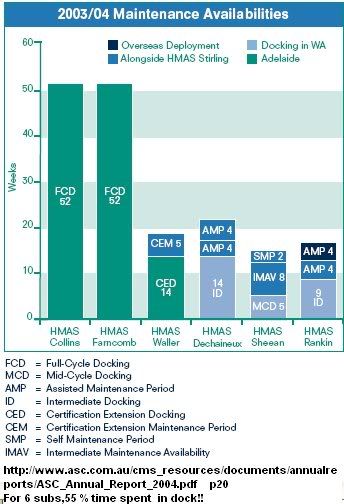
ss
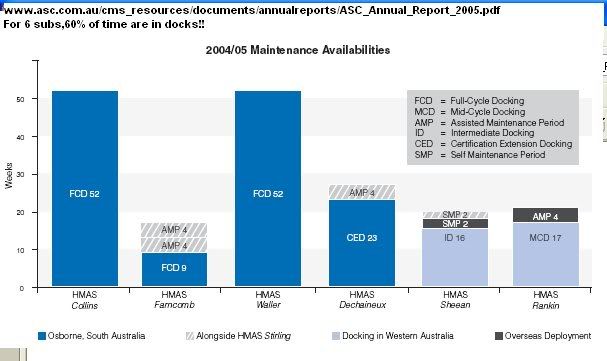
d
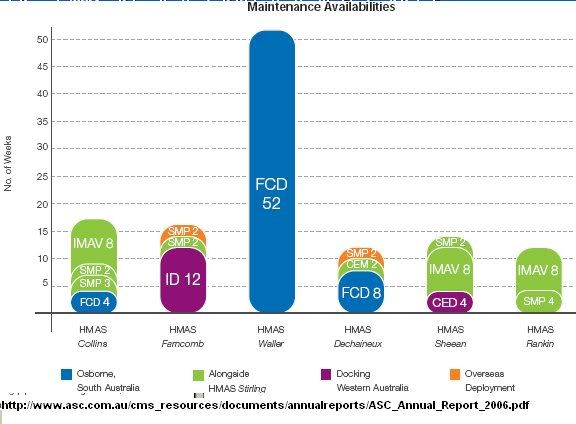
mmmm